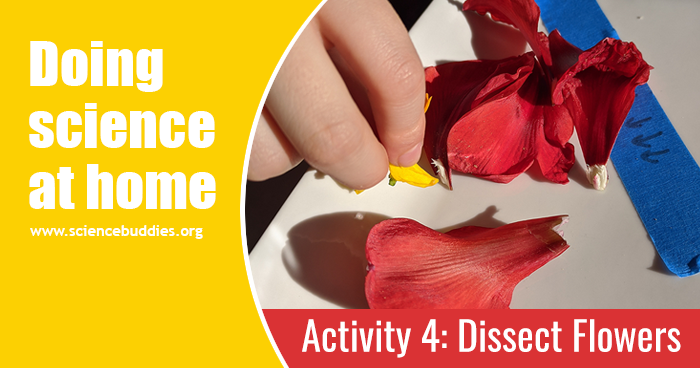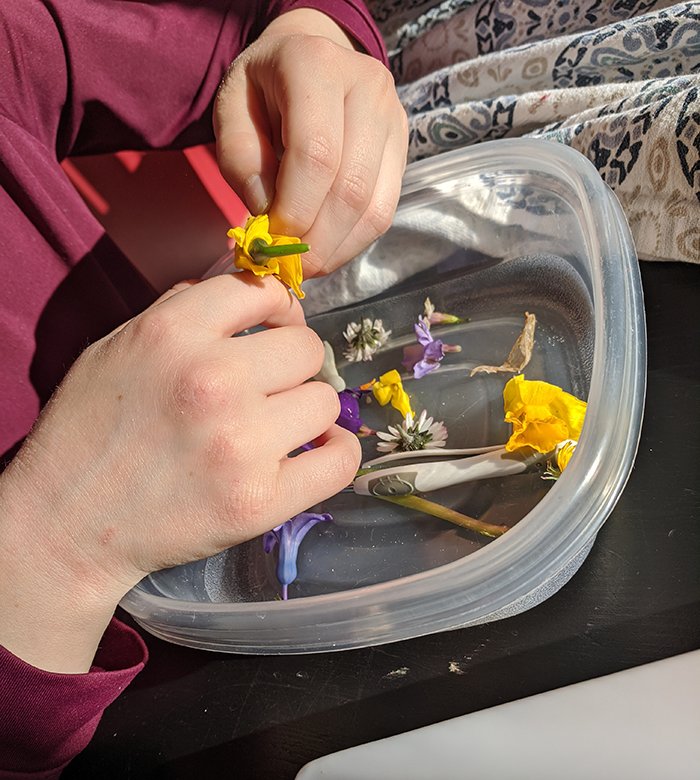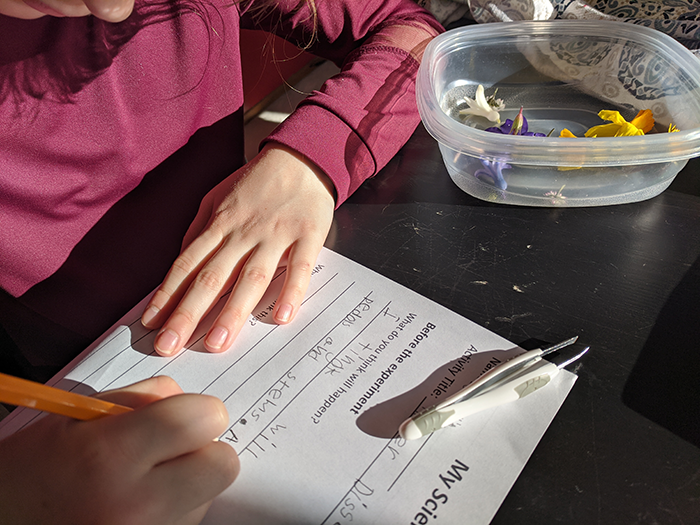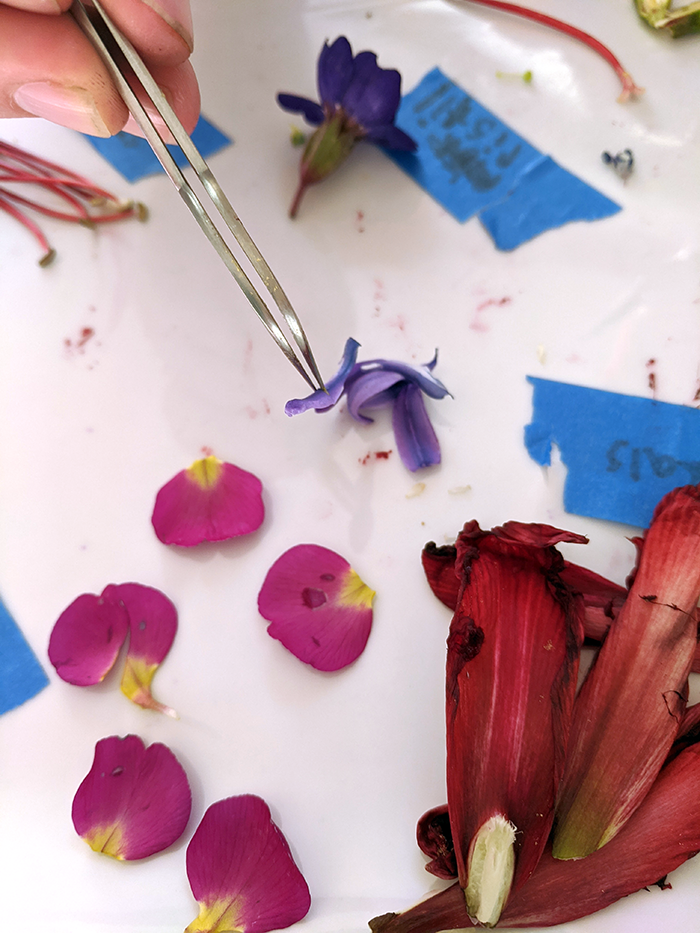Observing Nature: Doing Fun Science at Home during School Closures (Activity #4)
Follow along with a Science Buddies parent who is using family STEM activities to keep her kids learning at home during the COVID-19 school shutdown. New posts every Monday, Wednesday, and Friday. Today's adventure... a neighborhood walk leads to pulling apart flowers, all in the name of science.

Observing Nature Means a Little More Sanity
It's been exactly two weeks since school closed for us, and I've learned a lot about each of my family members, including that my children are capable of way more chores with way less complaining than I ever imagined — chalk that one up to a COVID-19 silver lining! The biggest lesson by far though has been that if we don't get outside, there will be a meltdown. So, we walk.
By now we've walked around our neighborhood at least fifty times, which, admittedly, gets boring unless you actively make a point to be observant about nature. We're on the cusp of spring where I live, so there's quite a bit to look at if you take the time to notice: leaves and flowers are budding, birds are returning, and the bugs are starting to emerge. While noticing and talking about all those changes are fun and perk up the same-old walk, it's also nice to bring a bit of nature back inside and examine, build, or investigate it up close.
Here are a few activities that will allow you to do that with your kids:
- Build a Bird Feeder to Study Birds: build a bird house or bird feeder and let nature come to you.
- Build a Bird Nest: imagine you are one of one of the birds in your neighborhood and try your hand at gathering and nest building.
- Explore Biodiversity Using a Homemade Bug Vacuum!: suck up those bugs and get a good look at them up close—don't forget to release them after!
- Dissect a Flower: sacrifice a few spring flowers to get a good look at their organs.
- Suck It Up! How Water Moves Through Plants: if outside isn't an option, grab some celery or cut flowers on your next grocery run and investigate how plants drink.
My Pick of the Day: Flower Dissecting
To be totally transparent, I've had my eye on the Dissect a Flower activity since my co-worker Svenja first wrote it up. Until now, there hasn't seemed to be a good moment to do it though. So, on one of our neighborhood walks, I took a plastic food storage container with me and naively challenged the kids to find some flowers. Friends, learn from my mistake — define the parameters of what is okay to pick before you set that challenge! Fortunately, the first beautiful flower victim was in my own yard, allowing us to back up and have that rule-setting conversation — our single daffodil was sacrificed in the name of science.
We ended up with an interesting collection of mostly weeds (dandelions and other daisy-like things I don't know the name of), flowers from ground cover (vinca), and abundantly flowering bushes (forsythia), along with my daffodil and a few pansies from our own yard.
We sat down with some tweezers and a diagram of flower parts and labeled one plate per kid for them to sort their flower parts onto. Tearing into the flowers was clearly the highlight for my second grader. She soon abandoned the delicate tweezers for the tactile joy of pulling the flower apart with her fingers.

While she had no trouble identifying and sorting the flower parts, I do wish we'd had more larger flowers. Our flower haul was mostly small-petaled with delicate parts. I ended up giving her the last two blooms, which were miraculously still on an Amaryllis plant I'd bought for Christmas. These were much bigger, and she enjoyed them even more and liked sketching what she found in her science activity log.

If I was repeating this science activity, I'd probably hold off until we had a few tulips or larger flowers in bloom or pick some up on my weekly grocery store run.
In contrast, my middle schooler was content to spend time painstakingly plucking off tiny dandelion petals with tweezers. To my surprise, he stuck with this activity for a long time (over an hour) and ended up with a nice collection of tiny plant organs.

Both kids say they'd do it again, so maybe we'll revisit this one when more things are in bloom.
If you have flowers handy, either blooming in your yard or bought at the grocery store, I'd love to know how this activity goes for you. As always, if you have questions or comments, drop me an email. drop me an email.
If this blog post was useful to you, please share it with other parents. Follow the links below to see what other science adventures at home we've been having.
View All Posts in this Series
- Activity 1 - Getting Started and Hand Washing
- Activity 2 - Taking Flight with Kites
- Activity 3 - Candle Seesaw and Fire Science
- Activity 4 - Dissecting Flowers
- Activity 5 - Building a Toy Parachute
- Activity 6 - Paper Marbling
- Activity 7 - Shaping Hard-boiled Eggs
- Activity 8 - Invisible Ink
- Activity 9 - Robot Hand
- Activity 10 - Plastic Egg Rockets
- Activity 11 - Rubber Band Guitar
- Activity 12 - Making Model Viruses
- Activity 13 - Air Cannons
- Activity 14 - Balancing an Art Mobile
- Activity 15 - Gumdrop Geometry
- Activity 16 - Solar Updraft Tower
- Activity 17 - Cotton Ball Launcher
- Activity 18 - Wire Water Striders
- Activity 19 - Ice Cream in a Bag
- Activity 20 - Wind-powered Sail Cars
- Activity 21 - Curling Metal
- Activity 22 - Popsicle Stick Catapult
- Activity 23 - Candy Diffusion
- Activity 24 - STEM Videos
- Activity 25 - Making Slime
- Activity 26 - Straw Siphon
- Activity 27 - Elephant Toothpaste
- Activity 28 - Balloon Hovercraft
- Activity 29 - Aluminum Foil Boats
- Activity 30 - Wall Marble Run
A science activity log is available as a Word document or as a Google doc for online convenience. (Just choose "File/Make a copy" to save it to your Google Drive.)
About the Author
Sandra, Science Buddies' Vice President of STEM education, holds a PhD in Genetics from Stanford University and has spent the last twelve years working on science education and STEM outreach. Right now, she's stuck working from her home in the Pacific Northwest with her husband, second grader, middle schooler, and two oddly noisy gerbils. She hypothesizes her sanity will hold as long as she gets a daily dose of sunshine.
Categories:
You Might Also Enjoy These Related Posts:
- Wall Marble Run: Doing Fun Science at Home during School Closures (Activity #30)
- Aluminum Foil Boats: Doing Fun Science at Home during School Closures (Activity #29)
- Hovercraft: Doing Fun Science at Home during School Closures (Activity #28)
- Elephant Toothpaste: Doing Fun Science at Home during School Closures (Activity #27)
- Straw Siphon: Doing Fun Science at Home during School Closures (Activity #26)
- Slime Three Ways: Doing Fun Science at Home during School Closures (Activity #25)
- A STEM Videos Breather: Doing Fun Science at Home during School Closures (Activity #24)
- Candy Experiments: Doing Fun Science at Home during School Closures (Activity #23)










